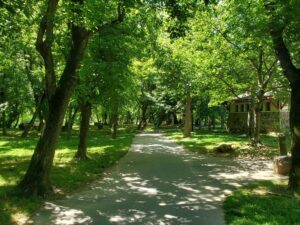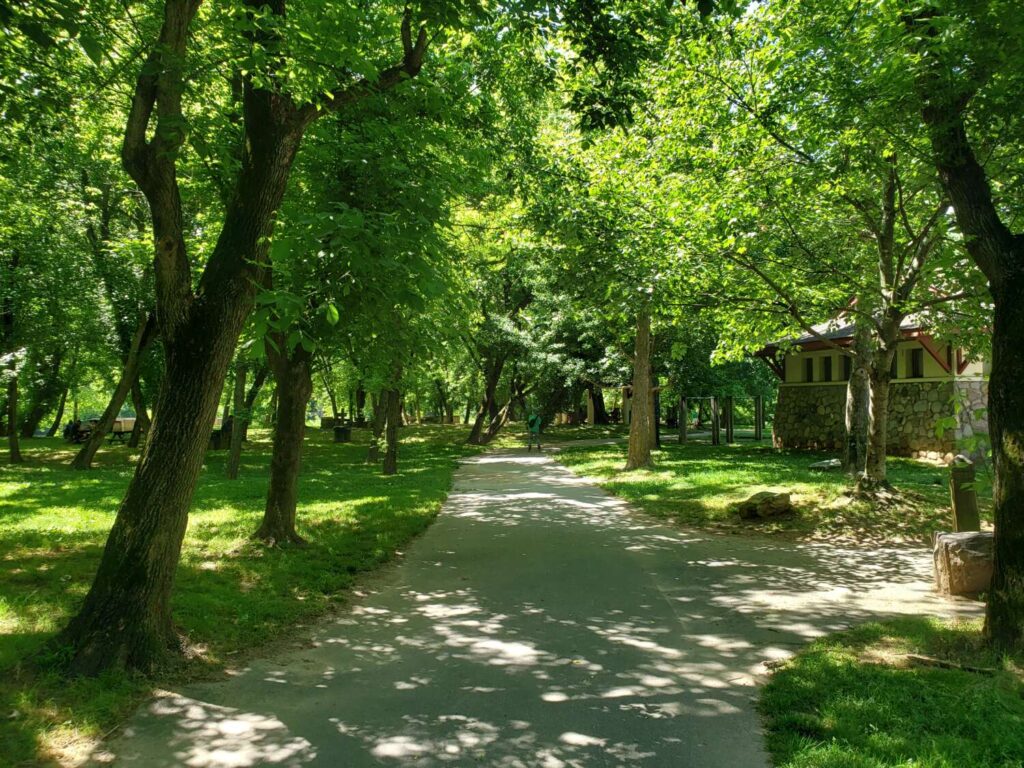The benefits of urban forests are immense.
Not only are trees valued for aesthetic beauty and shade, but tree cover in cities also provides benefits to human health and social well-being. Urban forests and greenery are associated with improved mental health and physical wellness.
Trees work as a part of the green infrastructure of a city to remove air pollution, mitigate stormwater, reduce flooding, sequester carbon dioxide, provide habitat for wildlife, and improve comfort and cooling for residents by mitigating the urban heat-island effect. Properly placed trees can reduce energy use for homes and businesses, as well as increase property values.
These social, economic, and environmental benefits of the urban forest all contribute to the triple bottom line of long-term sustainability in the City of Asheville.

The data
Like many growing cities, Asheville has struggled to balance the demand for new development with the need for a healthy, mature, and thriving tree canopy. Dedicated citizen groups, nonprofit partners, and city government have all worked together to address the problem of tree canopy loss.
The City of Asheville Urban Forestry Commission (UFC) initiated several key projects in the last few years to collect data and implement new policies for tree canopy protection.
In 2019, the city contracted with Davey Resource Group to study changes in Asheville’s tree canopy over the past decade. Data from 2008 was compared to 2018 conditions and found Asheville lost 6.4 percent of the total tree canopy in that time frame. The amount of tree canopy can also be used to calculate ecosystem services including carbon sequestration and stormwater capture.
In 2008, it is estimated that Asheville’s urban tree canopy coverage provided $82 million worth of carbon sequestration. Canopy loss in the next 10 years resulted in a loss of $7 million worth of carbon capture benefits. Additionally, from 2008 to 2018, the loss of canopy resulted in an increase in stormwater runoff that cost the city an estimated $1.6 million. Long-term planning to retain and increase canopy cover in the city is a goal that will save money in addition to preserving the legacy of natural beauty in Asheville.
In 2019, the city of Asheville worked with a team from NASA Develop to conduct a study on the urban heat-island effect, which explores the measurable increase in temperatures in a city compared to surrounding areas due to vegetation loss combined with heat capture from the built environment. The study found that census tracts with high vulnerability (high poverty and/or high rate of elderly residents) were often also those with low tree canopy and the highest temperatures.
This inequity in tree canopy distribution and the resulting impacts on human health and cooling costs aligns with recent research on historic redlining practices in Asheville and the impacts on tree canopy. Restoring the tree canopy in historically under-served neighborhoods will help ensure that trees are distributed more equitably in Asheville. Addressing this inequality of tree cover can improve living conditions for all city residents.
The ordinance
From this data, the UFC worked together with city staff to create a new Tree Canopy Protection Ordinance that updated the existing tree-save policies in the Unified Development Ordinance (UDO). The new ordinance uses the data from the canopy study along with a zoning overlay to structure the amount of canopy that must be preserved on a development site.
Asheville City Council voted unanimously to approve the ordinance in September 2020. Leaders cited the ordinance’s alignment with the Living Asheville Comprehensive Plan, particularly in creating a healthy and expanding urban tree canopy; protecting land and water assets; making streets more walkable, comfortable, and connected; and encouraging naturalized stormwater management techniques.
The Tree Canopy Protection Ordinance applies to most development sites within the city with the exception of single-family residences. Current restrictions to tree removal on steep slopes and within aquatic buffers were unchanged. The new rules take into account the current canopy cover on a development site, along with the location and type of land use. A matrix is used to calculate the amount of trees that will be required on each site, and provides options for meeting these requirements through preservation of existing trees, planting new trees, or paying a fee in lieu of meeting these criteria.
The ordinance puts an emphasis on saving existing trees in the calculation, adding an incentive for preservation. Preserving mature tree canopy is essential to achieve the key benefits of urban forests including climate change mitigation, energy savings, and stormwater management. Large trees are simply better at providing these services in the present rather than waiting decades from planting new trees. The ordinance is also designed to encourage landscape planning on development sites early in the design process. Proper pre-planning and site design for building projects can reduce job costs associated with landscaping and tree removal, in addition to increasing post-construction values.
Implementation of the City of Asheville’s Tree Canopy Protection Ordinance is a step in the right direction toward smart growth. Recognizing the value of trees and green infrastructure can help to guide policy and decision making for all stakeholders, from city government to land developers and residents. It pays off in the long run to follow green-building concepts that include site planning to maximize existing trees and vegetation resources. Such practices contribute to the triple bottom line of improving human health, the environment, and the economy.
By passing the new ordinance, the City of Asheville has also taken steps toward improving environmental equity in the city by creating the fee-in-lieu option that will collect funds to be used for various tree canopy enhancement efforts in areas of need.
Reversing the loss of Asheville’s tree canopy and eventually increasing tree cover will be a critical piece of climate resilience that will benefit residents and visitors alike.
Amy Smith is a professor of science at Purdue University Global and a REALTOR® with Modern Mountain Real Estate in Asheville. She is LEED AP accredited and holds a Master of Science in Forest Ecology and Management, as well as a Master of Science in Environmental Policy. Amy serves as the chair of the Asheville Urban Forestry Commission and is a volunteer member of the Asheville Tree Protection Taskforce.
You can also view this article as it was originally published on page 48 of the 2021-22 edition of the directory.


